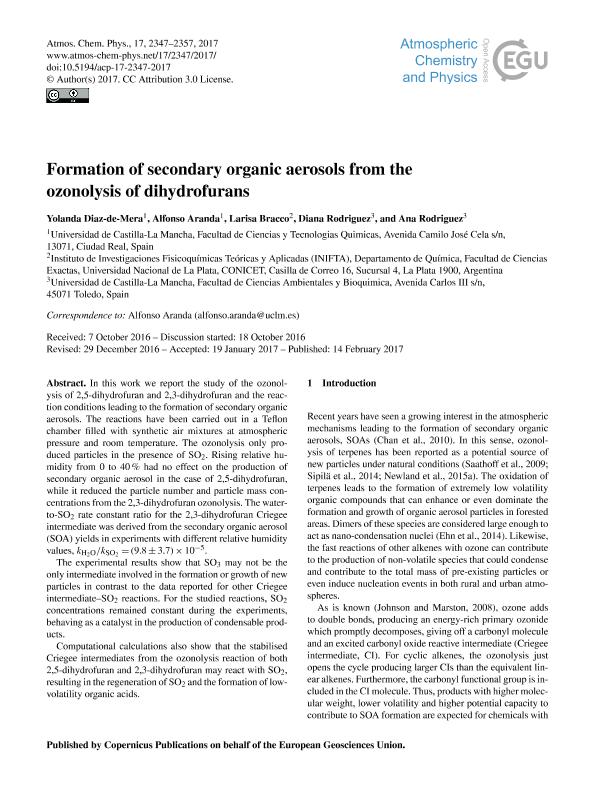Mostrar el registro sencillo del ítem
dc.contributor.author
Díaz de Mera, Yolanda
dc.contributor.author
Aranda Rubio, Alfonso

dc.contributor.author
Bracco, Larisa Laura Beatriz

dc.contributor.author
Rodríguez, Diana

dc.contributor.author
Rodríguez, Ana

dc.date.available
2019-08-05T23:21:54Z
dc.date.issued
2017-02
dc.identifier.citation
Díaz de Mera, Yolanda; Aranda Rubio, Alfonso; Bracco, Larisa Laura Beatriz; Rodríguez, Diana; Rodríguez, Ana; Formation of secondary organic aerosols from the ozonolysis of dihydrofurans; Copernicus Publications; Atmospheric Chemistry and Physics; 17; 3; 2-2017; 2347-2357
dc.identifier.issn
1680-7316
dc.identifier.uri
http://hdl.handle.net/11336/80961
dc.description.abstract
In this work we report the study of the ozonolysis of 2,5-dihydrofuran and 2,3-dihydrofuran and the reaction conditions leading to the formation of secondary organic aerosols. The reactions have been carried out in a Teflon chamber filled with synthetic air mixtures at atmospheric pressure and room temperature. The ozonolysis only produced particles in the presence of SO2. Rising relative humidity from 0 to 40% had no effect on the production of secondary organic aerosol in the case of 2,5-dihydrofuran, while it reduced the particle number and particle mass concentrations from the 2,3-dihydrofuran ozonolysis. The water-to-SO2 rate constant ratio for the 2,3-dihydrofuran Criegee intermediate was derived from the secondary organic aerosol (SOA) yields in experiments with different relative humidity values, kH2O/kSO2 = (9.8 ± 3.7) × 10-5. The experimental results show that SO3 may not be the only intermediate involved in the formation or growth of new particles in contrast to the data reported for other Criegee intermediate-SO2 reactions. For the studied reactions, SO2 concentrations remained constant during the experiments, behaving as a catalyst in the production of condensable products. Computational calculations also show that the stabilised Criegee intermediates from the ozonolysis reaction of both 2,5-dihydrofuran and 2,3-dihydrofuran may react with SO2, resulting in the regeneration of SO2 and the formation of low-volatility organic acids.
dc.format
application/pdf
dc.language.iso
eng
dc.publisher
Copernicus Publications

dc.rights
info:eu-repo/semantics/openAccess
dc.rights.uri
https://creativecommons.org/licenses/by/2.5/ar/
dc.subject
Aerosls
dc.subject
2,3 Dihydrofuran
dc.subject
2,5 Dihydrofuran
dc.subject
Criegee
dc.subject.classification
Otras Ciencias Químicas

dc.subject.classification
Ciencias Químicas

dc.subject.classification
CIENCIAS NATURALES Y EXACTAS

dc.title
Formation of secondary organic aerosols from the ozonolysis of dihydrofurans
dc.type
info:eu-repo/semantics/article
dc.type
info:ar-repo/semantics/artículo
dc.type
info:eu-repo/semantics/publishedVersion
dc.date.updated
2019-05-23T20:34:58Z
dc.identifier.eissn
1680-7324
dc.journal.volume
17
dc.journal.number
3
dc.journal.pagination
2347-2357
dc.journal.pais
Alemania

dc.journal.ciudad
Gotinga
dc.description.fil
Fil: Díaz de Mera, Yolanda. Universidad de Castilla-La Mancha; España
dc.description.fil
Fil: Aranda Rubio, Alfonso. Universidad de Castilla-La Mancha; España
dc.description.fil
Fil: Bracco, Larisa Laura Beatriz. Consejo Nacional de Investigaciones Científicas y Técnicas. Centro Científico Tecnológico Conicet - La Plata. Instituto de Investigaciones Fisicoquímicas Teóricas y Aplicadas. Universidad Nacional de La Plata. Facultad de Ciencias Exactas. Instituto de Investigaciones Fisicoquímicas Teóricas y Aplicadas; Argentina
dc.description.fil
Fil: Rodríguez, Diana. Universidad de Castilla-La Mancha; España
dc.description.fil
Fil: Rodríguez, Ana. Universidad de Castilla-La Mancha; España
dc.journal.title
Atmospheric Chemistry and Physics

dc.relation.alternativeid
info:eu-repo/semantics/altIdentifier/doi/http://dx.doi.org/10.5194/acp-17-2347-2017
dc.relation.alternativeid
info:eu-repo/semantics/altIdentifier/url/https://www.atmos-chem-phys.net/17/2347/2017/
Archivos asociados
